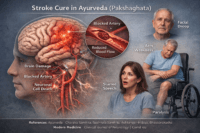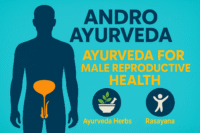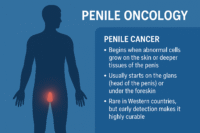- The Master Gland Behind Every Hormone
- How Modern Medicine Approaches Pituitary and Sellar Tumors
- The Ayurvedic Way of Restoring Hormonal Harmony
- Integrating Modern and Ayurvedic Wisdom
- Understanding the Pituitary and Sellar Region
- Symptoms
- Diagnosis
- Modern Medical Treatments: Strengths, Side Effects, and Limitations
- Ayurvedic Understanding- Healing the Root (Granthi and Dhatvagni Theory)
- Brahma Rasayana Avaleha (Medicine)
- Preparation Method of Brahma Rasayana
- Step 6: Finalization and Storage
- Precautions and Warnings
- Safety Instructions
- Important Note
- Limitations and Side Effects of Ayurvedic Therapy
- Frequently Asked Questions (FAQs)
- References
When a person is diagnosed with pituitary and sellar tumors, it can trigger deep concern and uncertainty. The word tumor often carries fear, yet in most patients, these growths are benign, slow-growing, and fully manageable [47]. They are rarely life-threatening when detected early and treated appropriately [47]. The key to confidence and recovery lies in understanding what pituitary and sellar tumors are, how they influence hormonal health, and what modern and Ayurvedic treatment paths exist for long-term healing.
The Master Gland Behind Every Hormone
The pituitary gland, located in the bony space called the sella turcica, is often described as the master gland of the body [48]. This tiny structure coordinates multiple hormones controlling the thyroid, adrenal glands, reproductive system, and metabolism [49]. When pituitary and sellar tumors develop in this area, they may disrupt these delicate functions. Patients often experience fatigue, weight fluctuations, mood swings, menstrual irregularities, infertility, or blurred vision when the tumor presses on the optic nerve. Even small hormonal imbalances from this gland can affect the entire body.
How Modern Medicine Approaches Pituitary and Sellar Tumors
Modern medical science provides advanced diagnostic tools to identify and manage pituitary and sellar tumors. MRI scans and hormonal profiling help determine the tumor’s size, type, and hormone activity with high precision [50]. In some patients, surgery or drug therapy becomes essential, especially when the tumor compresses nearby structures or produces excessive hormones [51]. These treatments can bring rapid relief and are life-saving in emergency cases. However, many patients face long-term side effects such as hormonal dependency, fatigue, and a risk of recurrence even after successful surgery [52]. While modern interventions remove the physical tumor, they often do not restore the gland’s natural intelligence or rhythmic function.
The Ayurvedic Way of Restoring Hormonal Harmony
Ayurveda views pituitary and sellar tumors as a sign of internal imbalance rather than a purely mechanical defect. It attributes their development to the disturbance of Kapha and Vata doshas and the weakening of Agni, the body’s metabolic fire [53]. This imbalance causes stagnation within Majja Dhatu—the tissue corresponding to the nervous and endocrine systems—and obstruction in the Shiras Srotas, or cranial channels [54]. Ayurvedic treatment aims to restore this balance through detoxification, Rasayana (rejuvenation), and lifestyle correction that revive the natural communication between the brain and hormones [55]. When Agni and Ojas regain their harmony, the body’s self-regulating intelligence naturally dissolves pathological growths and rebalances the endocrine axis.
Integrating Modern and Ayurvedic Wisdom
This guide combines the precision of modern endocrinology with the depth of Ayurvedic science to offer a complete understanding of pituitary and sellar tumors. It explores their diagnosis, symptoms, and treatment options, presenting the strengths, side effects, and limitations of both approaches. The goal is not to choose between the two systems but to bridge them—so that modern tools ensure safety and accuracy while Ayurveda restores natural hormonal balance, vitality, and long-term stability.
Understanding the Pituitary and Sellar Region

The Master Controller of Hormones
The pituitary gland is often called the master controller of the body’s hormonal system. It produces and regulates several essential hormones that influence major glands such as the thyroid, adrenal, and reproductive organs, as well as growth and metabolism. Even small changes in pituitary function can affect many body systems because this gland coordinates multiple feedback loops that maintain internal balance [48][49].
Location and Structure
This small, pea-sized gland sits in a bony cavity at the base of the brain known as the sella turcica. It lies just below the hypothalamus and is connected to it by a thin stalk called the infundibulum. This close relationship allows the brain and endocrine system to communicate efficiently, ensuring the timely release of hormones in response to the body’s needs [48].
Types of Pituitary and Sellar Tumors
Tumors that develop in the pituitary or sellar region are categorized based on their function. Functional tumors produce excessive amounts of hormones, leading to symptoms like rapid growth, menstrual irregularities, or hormonal imbalance. Non-functional tumors do not produce hormones but can cause pressure-related problems such as headaches or vision disturbances when they grow large enough to press on surrounding nerves or brain tissue [50].
Benign Nature of Most Tumors
Around ninety percent of pituitary and sellar tumors are benign adenomas. These are non-cancerous growths that typically remain confined to the pituitary gland and do not spread to other parts of the body [47]. Despite being benign, they can still interfere with hormone production or compress nearby structures, so medical attention is important.
Treatment Goals
The primary goals of treatment are to relieve pressure from the tumor, restore normal hormone levels, and prevent recurrence. In modern medicine, this may involve surgery, medication, or radiotherapy depending on the tumor’s type and size. In Ayurveda, the focus is on correcting the underlying metabolic and hormonal imbalance that allowed the growth to occur, using detoxification, Rasayana therapy, and lifestyle regulation to maintain long-term stability [53][55].
Symptoms
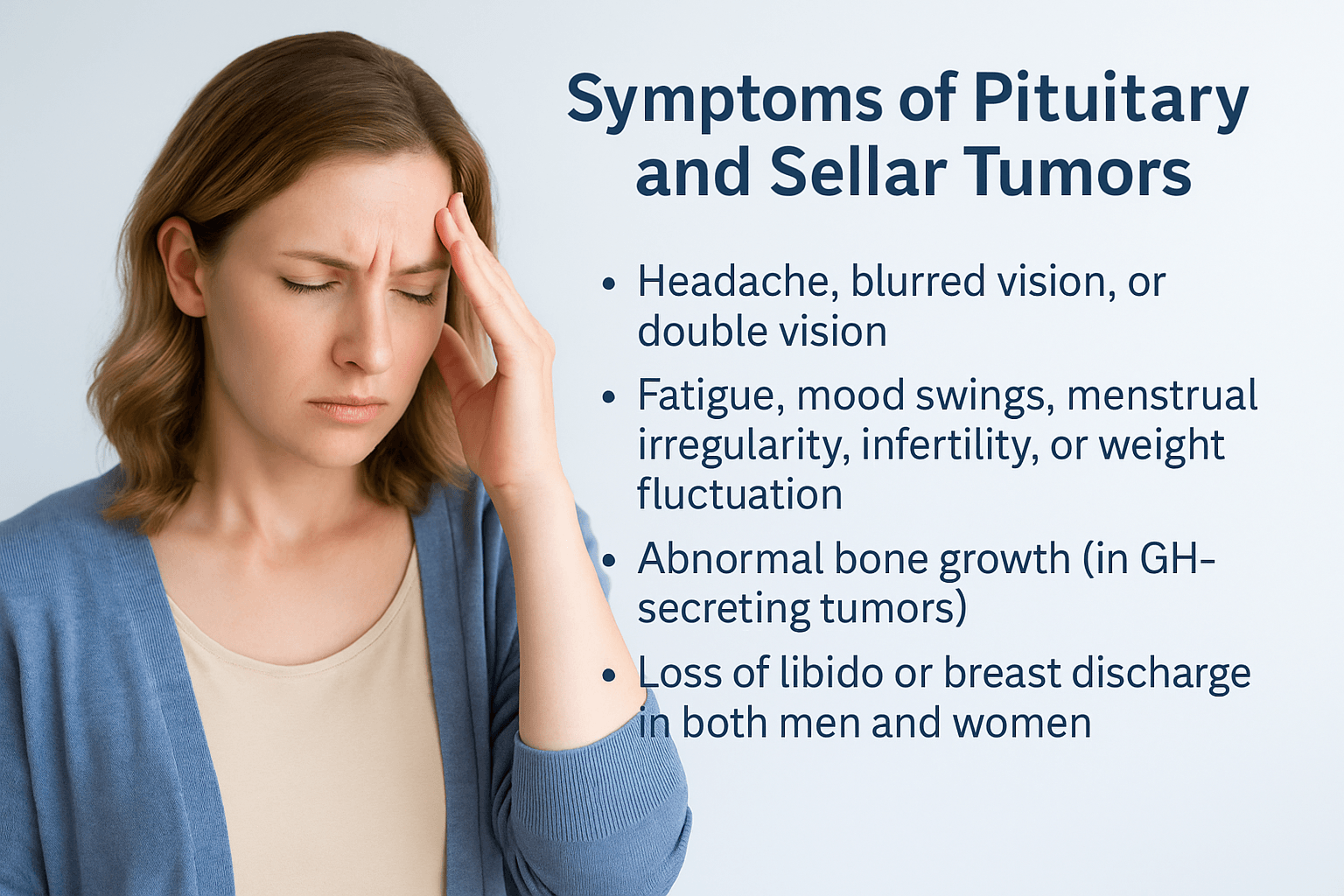
Early Signs and General Awareness
The symptoms of pituitary and sellar tumors often develop gradually, which means they can easily be mistaken for common health issues. Because the pituitary gland controls multiple hormones, even small disruptions in its function can affect many body systems at once. Recognizing these changes early can make diagnosis and treatment much easier [47][50].
Headache and Vision Changes
A dull, constant headache is one of the earliest and most common symptoms. This happens when the tumor puts pressure on the tissues inside the skull. If the tumor enlarges enough to press against the optic nerves, patients may notice blurred vision, double vision, or a gradual loss of peripheral sight. In rare cases, sudden bleeding inside the tumor (pituitary apoplexy) can cause severe headache, nausea, vomiting, and even temporary loss of consciousness, which requires emergency care [50].
Hormonal Imbalances and Systemic Effects
When the tumor affects hormone production, symptoms depend on which hormone is involved. Excess or deficiency of thyroid, adrenal, or reproductive hormones can lead to fatigue, mood swings, unexplained weight changes, and sleep disturbances [48][49].
- Overproduction of growth hormone can cause abnormal enlargement of hands, feet, or facial bones (acromegaly).
- Excess prolactin can lead to menstrual irregularities in women, impotence in men, and milk-like discharge from the breasts in both sexes.
- Reduced adrenal hormones may result in weakness, dizziness, or low blood pressure.
- Low thyroid hormones can cause dry skin, hair loss, and sluggish metabolism [49][50].
Reproductive and Emotional Symptoms
Loss of libido, infertility, erectile dysfunction in men, or difficulty conceiving in women are common results of disrupted hormone levels. These symptoms often carry emotional and psychological stress, leading to irritability, anxiety, or mild depression. Emotional instability may also occur due to hormonal fluctuations directly affecting neurotransmitter balance [49][50].
Rare and Advanced Symptoms
In some cases, large tumors can affect nearby brain structures, causing more serious or unusual symptoms. These may include persistent nasal drainage of clear fluid (from cerebrospinal leakage), sudden severe visual loss, drooping of the eyelid, facial numbness, or difficulty moving the eyes. Some patients also experience seizures, unsteady balance, or changes in smell and taste when the tumor extends beyond the sellar region [50].
The Importance of Awareness and Timely Evaluation
Each symptom should be viewed as a clue rather than a conclusion. Experiencing one or more of these signs does not confirm a tumor but indicates the need for medical evaluation. Early detection through MRI and hormonal testing can prevent complications and make recovery faster and safer. Combining timely diagnosis with appropriate medical or Ayurvedic treatment offers the best chance for complete restoration of health and hormonal stability [53][55].
Diagnosis
Imaging Tests for Accurate Detection
The first step in diagnosing pituitary and sellar tumors is imaging. Magnetic Resonance Imaging (MRI) or Computed Tomography (CT) scans allow doctors to visualize the size, shape, and location of the tumor [50]. MRI is preferred because it gives clearer images of soft tissues and can show whether the tumor is pressing on nearby nerves or structures. In some cases, a contrast dye is used to highlight the tumor and distinguish it from surrounding tissue.
Hormonal Evaluation
Because the pituitary gland controls many hormones, blood tests play an essential role in diagnosis. Doctors typically assess levels of thyroid-stimulating hormone (TSH), growth hormone (GH), prolactin, adrenocorticotropic hormone (ACTH), and cortisol [49][50]. These values help identify whether the tumor is functional (producing hormones) or non-functional (not producing hormones). For example, elevated prolactin suggests a prolactinoma, while high growth hormone indicates an acromegaly-type tumor.
Vision Assessment
If the tumor grows large enough to press on the optic nerves, it can affect vision. A visual field test helps detect any loss of peripheral vision, which is a common early sign of optic nerve compression [50]. This test is non-invasive and helps determine how urgently the tumor must be treated to prevent lasting vision problems.
Integrating Modern Diagnosis with Ayurvedic Planning
Ayurveda acknowledges the value of modern diagnostic tools for accurate assessment. Reports from MRI, CT scans, and hormonal profiles are used to create a personalized Rasayana and Shamana plan that matches the patient’s Dosha constitution and the tumor’s behavior [53][55]. This integrative approach ensures that treatment is both scientifically guided and tailored to the patient’s unique metabolic and psychological profile.
Modern Medical Treatments: Strengths, Side Effects, and Limitations

Medications
Medications are often the first line of treatment for pituitary and sellar tumors, especially those that produce hormones. The most common drugs used are dopamine agonists such as cabergoline, somatostatin analogues like octreotide, and various hormone regulators that help reduce the secretion of excess hormones [50][51].
Strengths
- Can shrink certain hormone-secreting tumors such as prolactinomas effectively.
- Non-invasive and often provide symptom relief within a short time.
- Help stabilize hormone levels and prevent complications related to hormonal imbalance.
Side Effects
- Nausea, dizziness, fatigue, and low blood pressure.
- Mood swings, depression, and sexual dysfunction.
- In some cases, gastrointestinal discomfort or headaches may occur.
Limitations
- Treats symptoms rather than the underlying cause of tumor formation.
- Tumor regrowth is possible if the medication is discontinued.
- Lifelong dependency is common, requiring continuous drug use to maintain balance.
- Long-term use can burden the liver and endocrine system, leading to secondary complications [52].
Surgery (Trans-sphenoidal Pituitary Surgery)
Trans-sphenoidal surgery is the most commonly performed operation for pituitary tumors. The surgeon accesses the gland through the nasal cavity, which avoids opening the skull and allows direct removal of the tumor [51].
Strengths
- Provides immediate relief from pressure on the optic nerves, often improving vision rapidly.
- Can remove large tumors and restore hormonal balance in many patients.
- Short hospital stay and faster recovery compared to open-brain surgery.
Side Effects
- Cerebrospinal fluid leakage and nasal drainage.
- Risk of infection or inflammation in the sinus or brain membranes.
- Hormonal imbalances post-surgery, sometimes leading to diabetes insipidus.
Limitations
- Complete removal may not be possible in invasive or irregularly shaped tumors.
- Hormone replacement therapy is often needed for life.
- Tumor recurrence occurs in 25–40% of cases within 5–10 years for certain adenomas [52].
Radiotherapy
Radiation therapy is reserved for patients who cannot undergo surgery or for those whose tumors return after initial treatment. Focused radiation is directed at the tumor to stop its growth or shrink it gradually [51][52].
Strengths
- Non-surgical and useful for patients who are not suitable for operation.
- Helps control tumor growth when other methods fail.
- Precise targeting techniques minimize damage to nearby tissues.
Side Effects
- Fatigue, memory issues, and gradual decline in cognitive sharpness.
- Hormonal decline or hypopituitarism developing months or years after treatment.
- In rare cases, radiation may lead to secondary cancers many years later.
Limitations
- Effects appear slowly and may take several years to become noticeable.
- Does not restore pituitary function or hormonal rhythm.
- Often used as a control method rather than a curative one.
Ayurvedic Understanding- Healing the Root (Granthi and Dhatvagni Theory)
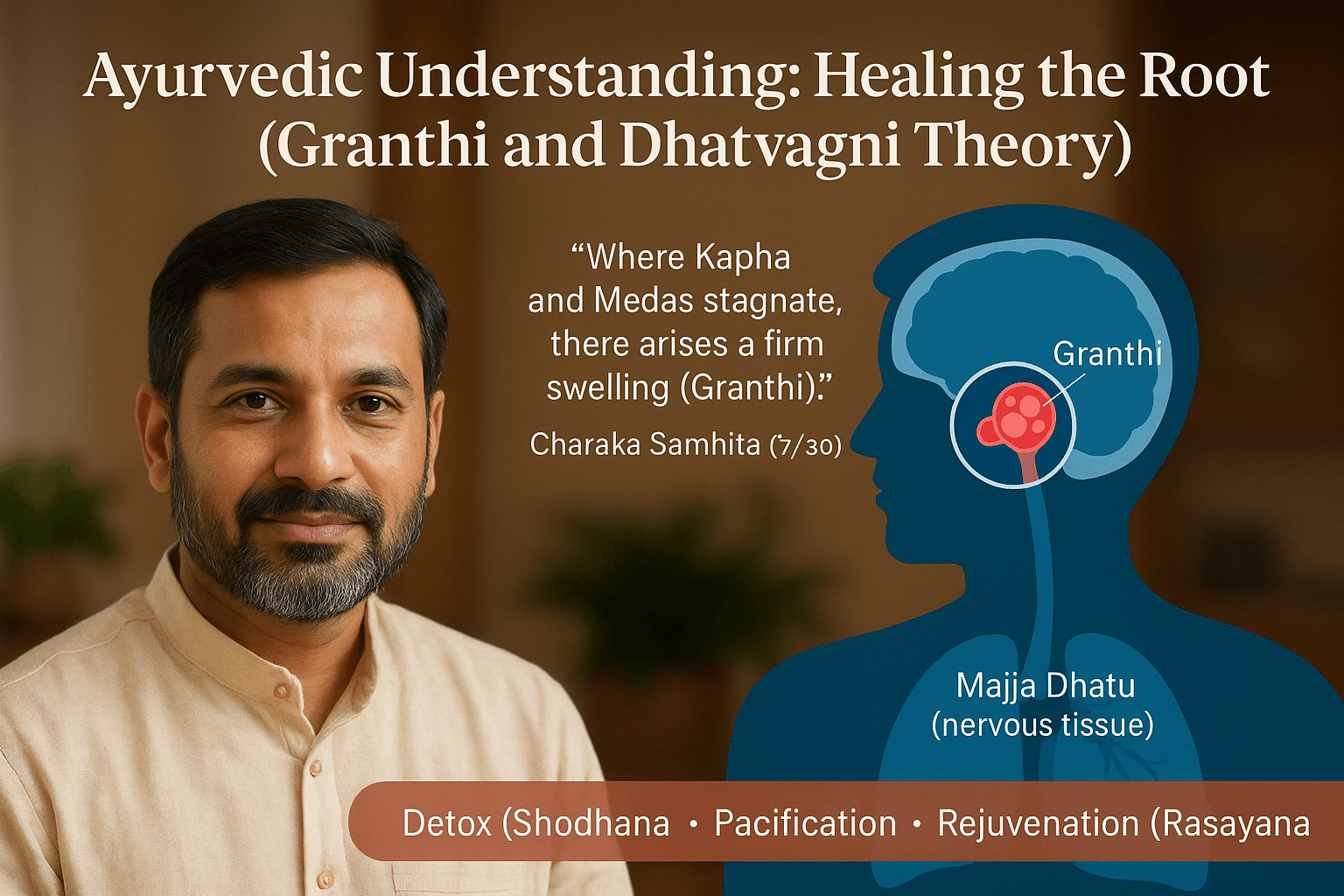
The Ayurvedic View of Granthi
In Ayurveda, abnormal glandular swellings such as pituitary or sellar growths are understood as Granthi, a condition formed by the stagnation of Kapha and Vata doshas within specific Dhatus (tissues). This vitiation primarily affects Majja Dhatu, which corresponds to the nervous and endocrine systems. When Kapha causes excessive accumulation and Vata creates irregular movement, a localized obstruction or knot-like swelling manifests.
The Charaka Samhita (Chikitsa Sthana 7/30) describes this clearly:
“Where Kapha and Medas stagnate, there arises a firm swelling (Granthi).”
This verse explains that when the body’s metabolic and circulatory harmony is disturbed, energy and nutrition fail to flow properly, leading to nodular formations that resemble benign glandular hypertrophy [53].
Understanding the Pathophysiology
Ayurveda attributes the development of such growths to Agnimandya, or the weakening of cellular and tissue metabolism (Dhatvagni). When Dhatvagni in Majja Dhatu is impaired, toxins (Ama) accumulate, causing heaviness and stagnation. Over time, this leads to structural changes or tissue overgrowth. In the case of the pituitary region, the obstruction interferes with hormonal coordination, mirroring how modern science explains the endocrine imbalance caused by pituitary adenomas [54].
The Healing Principle
Ayurvedic therapy focuses on restoring the body’s self-regulatory intelligence rather than suppressing symptoms. The main goal is to remove metabolic blockages, reawaken Agni (metabolic fire), and re-establish the rhythm of Ojas and hormones.
- Shodhana (Detoxification): Eliminates accumulated Kapha, Ama, and other obstructive impurities through Panchakarma procedures such as Virechana and Nasya.
- Shamana (Pacification): Uses herbal formulations like Kanchanar Guggulu and Triphala to reduce swelling and normalize tissue metabolism.
- Rasayana (Rejuvenation): Employs restorative compounds such as Brahmi, Ashwagandha, and Swarna Bhasma to nourish Majja Dhatu, support neuroendocrine balance, and strengthen Ojas [55].
The Ayurvedic Goal of Healing
Whereas modern medicine primarily removes or suppresses the tumor, Ayurveda aims to transform the terrain that allowed it to form. By cleansing accumulated toxins, balancing doshas, and rekindling Dhatvagni, the treatment targets the root cause of the disorder. As the inner metabolism stabilizes, the body naturally corrects tissue overgrowth and restores hormonal harmony — leading not only to remission but to true healing of the endocrine system.
Brahma Rasayana Avaleha (Medicine)
What Is Brahma Rasayana
Brahma Rasayana is a classical Ayurvedic herbal preparation revered as the ultimate Rasayana — a rejuvenative formulation that restores vitality, mental clarity, and hormonal balance. Its name derives from “Brahma,” symbolizing supreme consciousness and intellect. Traditionally mentioned in Charaka Samhita (Chikitsa Sthana 1/1–4) and Bhavaprakasha Nighantu (Rasayana Adhyaya), it was prescribed to enhance memory, intellect, and longevity while correcting the underlying derangements in Majja Dhatu (nervous tissue) and the endocrine axis.
For Western readers, Brahma Rasayana can be understood as a natural neuroendocrine and immune adaptogen. It works to harmonize the brain–pituitary–adrenal (HPA) axis, protect neurons, and slow cellular aging — akin to how adaptogenic tonics like ginseng or ashwagandha function, but with broader restorative depth. In pituitary and sellar tumors, it supports recovery by modulating hormonal feedback, improving tissue oxygenation, and dissolving Granthi (glandular obstructions) caused by Kapha–Vata imbalance.
Taste and Sensory Experience
The taste of Brahma Rasayana is a unique combination of Madhura (sweet), Kashaya (astringent), and Tikta (bitter) flavors. The initial sweetness comes from ingredients like Amalaki (Indian Gooseberry) and Sharkara (sugar), which soothe the palate and help carry the deeper herbal actives into tissues. The slight bitterness and astringency come from rejuvenative herbs such as Guduchi (Tinospora cordifolia), Haritaki, and Yashtimadhu (Licorice), which cleanse and tone the channels.
For Western patients, it tastes like a mildly sweet herbal jam — earthy and grounding, with a complex aftertaste reminiscent of molasses mixed with tonic herbs. Despite its unusual flavor, many find it deeply satisfying when taken regularly, as it imparts a sense of calm energy and improved concentration within days.
Ayurvedic Insight for Global Readers
In Ayurveda, taste (Rasa) is therapeutic — not just sensory. The sweet aspect nourishes and rebuilds depleted tissues (Dhatus), the bitter removes toxins and excess Kapha, and the astringent tones and strengthens. Together, these create a synergistic Rasayana effect that rejuvenates the entire system from cellular level up, making Brahma Rasayana one of the most comprehensive natural formulations for longevity, hormonal balance, and brain health.
Preparation Method of Brahma Rasayana
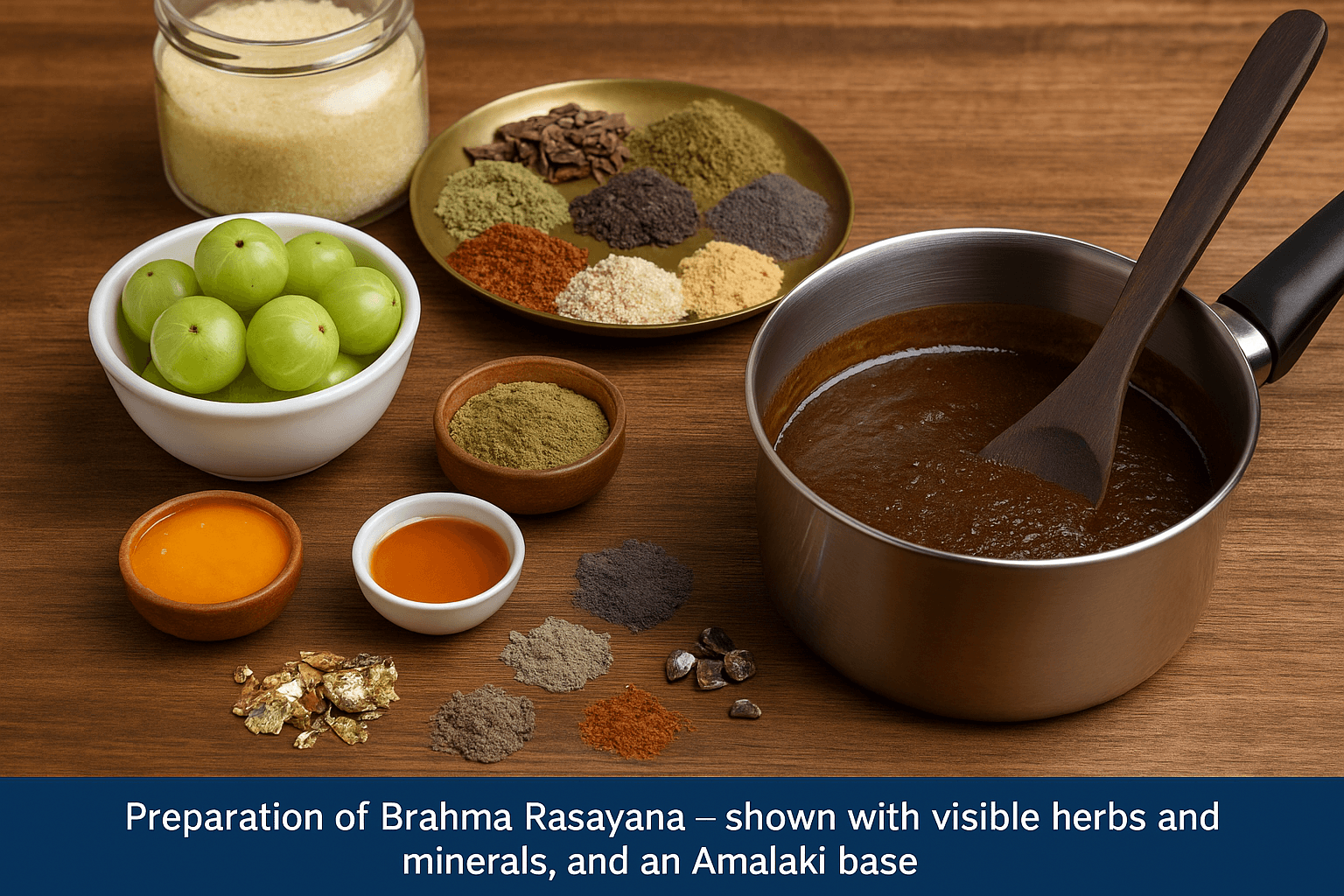
Step 1: Base Decoction (Kashaya Nirmana)
Take fresh Amalaki (Emblica officinalis) 1 kg or dried Amalaki 500 g and boil in 4 litres of water until it reduces to about 1 litre. This concentrated decoction forms the antioxidant base of the formulation, protecting Majja Dhatu and correcting Dhatvagni (tissue metabolism).
Now add the following herbs into this decoction and continue boiling on low flame for 45–60 minutes:
Guduchi (Tinospora cordifolia) 200 g, Brahmi (Bacopa monnieri) 150 g, Shankhpushpi (Convolvulus pluricaulis) 100 g, Mandukaparni (Centella asiatica) 100 g, Haritaki (Terminalia chebula) 100 g, Bibhitaki (Terminalia bellirica) 100 g, Ashwagandha (Withania somnifera) 150 g, Yashtimadhu (Glycyrrhiza glabra) 100 g, Punarnava (Boerhavia diffusa) 100 g, Gokshura (Tribulus terrestris) 100 g, Kanchanar (Bauhinia variegata) 100 g, Varuna (Crataeva nurvala) 75 g, Jyotishmati (Celastrus paniculatus) 25 g, Pippali (Piper longum) 25 g, Vacha (Acorus calamus) 25 g, and Jatamansi (Nardostachys jatamansi) 50 g.
Boil gently until the liquid reduces again to around 1 litre, ensuring all active principles are extracted. Filter through a fine muslin cloth to remove coarse residues.
Step 2: Ghee Integration (Sneha Kalpana)
Pour the filtered decoction into a clean vessel and add pure cow ghee 200 g. Maintain low heat and stir continuously until the ghee mixes evenly. This step enables the Rasayana to reach the Majja Dhatu (nervous and endocrine tissue) since ghee acts as the vehicle to cross the blood-brain barrier in Ayurvedic pharmacology.
Step 3: Sweetening and Avaleha Formation
Add Sharkara (refined sugar) 500 g to the warm mixture and continue stirring on mild heat until it thickens. When a drop between fingers forms a short sticky thread (tantra test), remove the vessel from the flame and allow it to cool slightly (below 40°C). Add Madhu (honey) 250 g and mix thoroughly.
This creates the soft, semisolid Avaleha texture — the classical base for Brahma Rasayana.
Step 4: Addition of Aromatic and Bioavailability Herbs
As the Avaleha begins to cool but before honey is added, blend in fine powders of the following herbs:
Shunthi (Zingiber officinale) 50 g, Maricha (Piper nigrum) 20 g, Ela (Elettaria cardamomum) 10 g, Tvak (Cinnamomum verum) 10 g, Tejapatra (Cinnamomum tamala) 10 g, Lavanga (Syzygium aromaticum) 5 g, and Nagakesara (Mesua ferrea) 10 g.
These aromatics improve Agni, aid digestion, and ensure deep cellular penetration of Rasayana components.
Step 5: Addition of Mineral Rasayanas (Bhasma Integration)
After the Avaleha cools below 40°C, carefully add the following pharmaceutically purified mineral preparations (all GMP-certified). Stir thoroughly for uniform distribution.
Swarna Bhasma (Gold Calx) 250 mg – Restores hypothalamic-pituitary-adrenal coordination, rejuvenates Ojas.
Abhrak Bhasma (Sahasraputi) 500 mg – Strengthens Majja Dhatu and enhances hormonal regulation.
Suvarna Makshik Bhasma 500 mg – Regulates thyroid, adrenal, and pituitary rhythms.
Loha Bhasma 250 mg – Improves tissue metabolism and oxygen transport.
Mukta Shukti Bhasma 500 mg – Balances calcium metabolism, supports glandular stability.
Pravala Pishti 250 mg – Provides trace minerals and anti-inflammatory effect.
Godanti Bhasma 250 mg – Reduces Pitta and helps in hormonal heat regulation.
Trivanga Bhasma 500 mg – Corrects reproductive and endocrine imbalance.
Rajata Bhasma 125 mg (optional) – Supports brain clarity and medhya function.
Heerak Bhasma 50–100 mg (optional) – Strengthens DNA integrity and prevents recurrence of glandular proliferation.
Each mineral should be added one at a time while gently stirring. Never add these while the mixture is hot to avoid loss of potency.
Step 6: Finalization and Storage
Mix the entire mass until smooth and glossy. Transfer to sterilized glass jars and store in a cool, dry, shaded place. Properly sealed, it remains potent for up to 12 months.
Dosage and Duration
Take 15 grams twice daily after meals with lukewarm milk or a honey–ghee mixture as Anupana.
Dietary and Lifestyle Guidance
Eat warm, freshly cooked meals rich in ghee, green moong, and Amalaki preparations.
Avoid curd, fermented foods, pickles, red chili, and sour fruits.
Prefer early bedtime and regular bowel habits. Triphala Churna at night can be used if mild constipation occurs.
Avoid long gaps between doses, as missed doses delay Rasayana action.
Expected Clinical Outcomes
- Gradual normalization of pituitary hormone levels (TSH, GH, ACTH, prolactin).
- Reduced fatigue, headache, and visual disturbance due to improved circulation and hormonal regulation.
- Rejuvenation of Majja Dhatu and restoration of sleep, focus, and mental stability.
- Prevention of relapse through deep detoxification and Dhatvagni correction.
Safety and Precautions
- Always use genuine, pharmaceutically purified Bhasmas.
- Avoid unsupervised combination with corticosteroids or hormonal drugs.
- Conduct baseline and 30-day laboratory monitoring (CBC, LFT, RFT, TSH, prolactin, cortisol).
- Discontinue immediately if metallic taste, nausea, or heaviness occurs — adjust dosage or switch to Rasayana-only variant.
Precautions and Warnings
Brahma Rasayana is a highly potent Rasayana formulation prepared from multiple herbs and mineral Bhasmas. Its ingredients, weights, and combinations must never be standardized blindly. The exact formulation varies according to several patient-specific factors, and improper use may lead to imbalance or toxicity.
Individual Factors Affecting the Formula
- Prakriti (Body Constitution): Vata, Pitta, and Kapha dominance determine which herbs or Bhasmas need to be emphasized or reduced.
- Vikruti (Current Dosha Imbalance): Acute Kapha-Vata aggravation in glandular swellings demands stronger Granthi-Nashaka and Agni-rekindling herbs, while high Pitta types require cooling Rasayanas.
- Dhatu Status: Weak Majja or Ojas requires gentle rejuvenation; strong Kapha-Medas accumulation needs detoxification before Rasayana use.
- Age and Strength: Elderly or debilitated patients require lower doses and longer intervals; younger, strong patients can tolerate higher potency.
- Disease Stage: Active glandular swelling, post-surgery recovery, or chronic hormonal suppression all need different herb–mineral ratios.
- Co-existing Conditions: Diabetes, hypertension, renal or liver disorders, or thyroid disease necessitate careful selection of sweeteners, ghee, and metallic Bhasmas.
- Allopathic Drug Use: Concomitant hormonal, steroidal, or psychotropic medications can interact with certain Rasayanas, requiring precise timing and physician monitoring.
Safety Instructions
- Always take under the direct supervision of a qualified Ayurvedic physician experienced in Rasayana and Rasa-Shastra formulations.
- Never self-prepare or self-prescribe this formulation from online recipes or non-certified sources.
- Use only GMP-certified Bhasmas from reputed Ayurvedic pharmacies.
- Avoid during pregnancy, lactation, or acute infections unless prescribed by your physician.
- Patients with elevated liver enzymes, kidney disorders, or uncontrolled diabetes should undergo periodic lab monitoring every 4–6 weeks.
- If symptoms such as metallic taste, nausea, skin rashes, heaviness, or digestive discomfort occur, stop use and seek immediate medical advice.
- Keep the formulation away from children and store it in a cool, dry place.
- Do not mix with alcohol, fermented foods, or synthetic hormones without guidance.
Important Note
The formulation’s exact composition, weight, and proportion of each herb or mineral will vary from patient to patient depending on Prakriti, disease stage, metabolic strength, and concurrent medications. Hence, Brahma Rasayana should never be replicated using fixed ratios. It is always customized after careful evaluation of the individual’s clinical, hormonal, and digestive profile.
Properly prescribed and monitored, Brahma Rasayana serves as one of Ayurveda’s safest and most powerful neuro-endocrine Rasayanas. Unsupervised use, however, may disturb doshic equilibrium and weaken Agni, defeating its rejuvenative purpose.
Limitations and Side Effects of Ayurvedic Therapy
Ayurveda offers a holistic and curative approach rather than a symptomatic or suppressive one. However, like all systems of medicine, its effectiveness depends on proper diagnosis, formulation accuracy, and disciplined follow-up. When misused or unsupervised, even the best formulations may not yield the desired outcome.
1. Slow onset of action:
Ayurvedic therapy heals by correcting the root cause, which takes time. Noticeable improvement generally occurs over weeks to months, not days. Patients expecting instant results may feel discouraged during the early phase.
2. Herb–drug interactions:
If a patient is taking strong allopathic medicines such as steroids, thyroid hormones, dopamine agonists, or antidepressants, the combination must be supervised by a qualified physician. Simultaneous or unsupervised use can alter absorption or metabolism.
3. Quality of ingredients:
The therapeutic success of Rasayana formulations depends on sourcing genuine, purified, and properly calcined Bhasmas. Unregulated or uncertified preparations can contain unsafe metal residues, leading to toxicity instead of rejuvenation.
4. Dietary discipline (Pathya–Apathya):
Ayurvedic therapy demands strict adherence to diet and lifestyle rules. Ignoring these guidelines—such as consuming sour, fermented, or heavy foods—can block the channels (Srotas) and hinder the action of Rasayanas.
5. Dependence on practitioner expertise:
Ayurvedic treatment is not one-size-fits-all. Each prescription must be customized according to Prakriti (body constitution), Vikruti (disease state), age, digestive fire (Agni), and strength. Incorrect combinations or dosing may aggravate doshas or delay recovery.
6. Requirement of emotional patience and consistency:
Ayurvedic healing depends on gradual reprogramming of cellular and hormonal balance. Results may be subtle at first, but they consolidate over time. Interrupting the course or losing faith mid-way often reverses progress.
7. Limitations in emergency care:
Ayurveda is not a substitute for surgical or acute emergency interventions. It is most effective as a restorative and preventive approach, not for immediate crisis management.
8. Individual variation in response:
Two patients with the same diagnosis may respond differently to the same medicine due to differences in digestion, mental stress, or toxin load (Ama). Regular review by the physician ensures appropriate adjustment.
9. Environmental and lifestyle influences:
Stress, irregular sleep, polluted food, or exposure to chemicals can counteract therapy. Ayurveda demands lifestyle correction alongside medicine for sustained benefit.
Frequently Asked Questions (FAQs)
1. What are Pituitary and Sellar Tumors?
Pituitary and sellar tumors are abnormal growths near the base of the brain, where the pituitary gland sits in a bony cavity called the sella turcica. Most are benign adenomas, not cancerous, but they can affect hormone production and press on nearby structures such as the optic nerves, causing symptoms like headache, vision problems, or hormonal imbalance.
2. Are Pituitary Tumors Life-Threatening?
In most cases, no. About 90% of pituitary tumors are non-cancerous (benign). However, if left untreated, large tumors can compress nerves or alter hormone levels, leading to complications such as thyroid, adrenal, or reproductive dysfunction.
3. How Does Ayurveda Explain Pituitary and Sellar Tumors?
Ayurveda describes these growths as Granthi—firm swellings caused by accumulation of Kapha and Vata doshas and stagnation of metabolic fire (Dhatvagni) in Majja Dhatu (nervous tissue). This blockage prevents normal hormone flow and communication between glands, leading to swelling and dysfunction.
4. What Is the Goal of Ayurvedic Treatment for Pituitary Tumors?
The aim is not merely to shrink the tumor but to restore the body’s self-regulating intelligence. Ayurvedic therapy focuses on clearing obstructions (Shodhana), balancing doshas (Shamana), and rejuvenating the endocrine tissues (Rasayana). This restores hormonal rhythm, prevents relapse, and strengthens immunity.
5. How Does Brahma Rasayana Help in Pituitary and Sellar Tumors?
Brahma Rasayana is Ayurveda’s most powerful brain and endocrine rejuvenator (Param Rasayana). It nourishes Majja Dhatu, improves hormonal communication, and removes Kapha–Vata obstruction that forms Granthi. Over time, it helps reduce glandular swelling, enhances vitality, and stabilizes hormone secretion naturally.
6. What Are the Key Herbs Used in Brahma Rasayana?
The formulation combines classical Rasayana and Medhya herbs such as Amalaki, Guduchi, Brahmi, Shankhpushpi, Mandukaparni, Ashwagandha, Yashtimadhu, Haritaki, Bibhitaki, Punarnava, Gokshura, and Jatamansi. Together, these herbs detoxify, rebuild Majja Dhatu, and support neuroendocrine balance.
7. Which Minerals Are Added for Endocrine Rejuvenation?
Physician-supervised Rasayana preparations may include mineral Bhasmas like Swarna Bhasma, Abhrak Bhasma, Suvarna Makshik Bhasma, Mukta Shukti Bhasma, Loha Bhasma, and Trivanga Bhasma. These enhance cellular repair, DNA stability, and hormone feedback mechanisms. Only GMP-certified and properly purified Bhasmas should be used.
8. How Is Brahma Rasayana Prepared?
The process involves boiling Amalaki with rejuvenative herbs to create a concentrated decoction, blending with ghee and sugar, and then adding honey and mineral Rasayanas after cooling. This ensures potency without damaging the active ingredients. The final Avaleha (paste) is stored in airtight glass jars.
9. What Is the Recommended Dosage?
The standard dose is 15 grams twice daily after meals with lukewarm milk or a ghee-honey mixture. The usual course lasts 30 days, extendable to 90 days based on response and physician evaluation.
10. Can I Prepare or Take Brahma Rasayana at Home?
No. Brahma Rasayana contains potent ingredients and mineral Bhasmas that require pharmaceutical precision. Self-preparation or unsupervised use is unsafe. Always take this under the guidance of a qualified Ayurvedic physician trained in Rasa-Shastra.
11. Are There Any Side Effects?
When properly prescribed, Brahma Rasayana is safe. However, if uncertified Bhasmas are used or dosing is incorrect, it may cause nausea, heaviness, or metallic taste. Rarely, unregulated formulations may lead to liver stress or mineral overload. Hence, clinical monitoring is essential.
12. Why Do Ayurvedic Results Take Time?
Ayurveda corrects imbalances at the cellular level rather than suppressing symptoms. Results appear gradually—usually over weeks to months—as metabolism, hormones, and tissues realign naturally. Consistency and patience are key to success.
13. Can I Take Ayurvedic Medicine Along with Modern Hormone Therapy?
Yes, but only under medical supervision. Certain herbs and Bhasmas may alter hormone absorption or metabolism. Your Ayurvedic physician will schedule doses to prevent interaction with allopathic drugs.
14. Is Panchakarma Required for Pituitary Tumors?
Panchakarma is optional but can accelerate recovery. Therapies such as Nasya (nasal therapy), Virechana (purgation), and Basti (enema) clear Kapha–Vata obstruction, detoxify endocrine channels, and enhance Rasayana absorption.
15. Who Should Avoid This Treatment?
Avoid or postpone Rasayana therapy during acute infections, uncontrolled diabetes, pregnancy, or severe liver and kidney disorders unless specifically advised by a physician.
16. What Precautions Should I Follow During Therapy?
Follow a light, sattvic diet with ghee, green moong, and Amalaki. Avoid curd, pickles, sour fruits, fried, and fermented foods. Maintain regular sleep, avoid late nights and sexual exhaustion, and stay emotionally balanced.
17. Why Does the Ingredient Weight Differ Between Patients?
Ayurveda customizes every formulation based on Prakriti (body constitution), Vikruti (current imbalance), age, strength, digestion, and coexisting illnesses, as well as stage of tumor and hormone status. Thus, no two Brahma Rasayana formulations are identical. The ratio and weight of each herb or mineral change according to patient requirements.
18. Can I Buy Ready-Made Brahma Rasayana from the Market?
Commercial Brahma Rasayanas are general-purpose tonics, not disease-specific neuroendocrine preparations. For therapeutic use in pituitary disorders, only custom-compounded, physician-formulated batches are recommended.
19. What Laboratory Tests Should Be Monitored During Therapy?
Your doctor may advise periodic tests such as CBC, LFT, RFT, fasting glucose, TSH, FT4, prolactin, cortisol, and IGF-1 (if GH excess is suspected). These track both hormonal and systemic response to therapy.
20. What Makes Ayurvedic Treatment Different from Modern Medicine?
Modern medicine primarily focuses on removal—through drugs, surgery, or radiation—while Ayurveda focuses on retraining the gland to self-heal. Modern treatments offer immediate relief but often lead to hormonal dependence and recurrence, whereas Ayurveda works slowly but aims for permanent restoration of balance.
21. What Are the Common Mistakes Patients Make During Treatment?
Skipping doses, consuming incompatible food, using non-certified medicines, or stopping treatment prematurely are common errors. Ayurveda demands consistency, trust, and supervision for the best results.
22. How Soon Can I Expect Improvement?
Most patients notice better sleep, reduced fatigue, improved concentration, and stable mood within three to four weeks. Hormonal normalization typically follows in eight to twelve weeks, depending on chronicity and adherence to diet and routine.
23. Is Brahma Rasayana Safe for Long-Term Use?
Yes, when prescribed individually and monitored properly. It nourishes all seven Dhatus, especially Majja and Shukra, promoting long-term vitality, memory, and hormonal stability without dependency.
24. Does Ayurveda Cure Pituitary Tumors Completely?
In benign cases, Ayurveda can often reverse swelling, correct hormone imbalances, and prevent recurrence. For advanced or invasive tumors, it serves as a supportive therapy that improves quality of life, prevents regrowth, and reduces dependency on synthetic hormones.
References
[47] Charaka Samhita, Chikitsa Sthana 1/1–4. In: Sharma PV (Trans.). Chaukhamba Orientalia, Varanasi; 2019. “Brahma Rasayanam medhābalāyuṣyakaram param” – The supreme Rasayana enhancing intellect, strength, and longevity.
[48] Bhavaprakasha Nighantu, Rasayana Adhyaya, Verse 1–14. Commentary by Bhavamishra. Chaukhamba Bharati Academy, Varanasi; 2020. Description of Brahma Rasayana as the highest rejuvenator for mental and glandular health.
[49] Singh RH, Narsimhamurthy K, Singh G. “Neuropharmacological and endocrine effects of Medhya Rasayanas (nootropic Ayurvedic herbs).” Phytotherapy Research. 2010;24(8):1102–1110. https://doi.org/10.1002/ptr.3099
[50] Melmed S. “Pathogenesis of pituitary tumors.” Nature Reviews Endocrinology. 2011;7(5):257–266. https://doi.org/10.1038/nrendo.2011.40
[51] Asa SL, Ezzat S. “The pathogenesis of pituitary tumors.” Annual Review of Pathology: Mechanisms of Disease. 2009;4:97–126. https://doi.org/10.1146/annurev.pathol.4.110807.092259
[52] Molitch ME. “Diagnosis and treatment of pituitary adenomas: a review.” JAMA. 2017;317(5):516–524. https://doi.org/10.1001/jama.2016.19699
[53] Charaka Samhita, Chikitsa Sthana 7/30. “Yatra kaphaśca medaśca saṁcitaṁ tatra granthirbhavati.” Translation: “Where Kapha and Medas accumulate, there arises a firm swelling (Granthi).” Chaukhamba Sanskrit Series, Varanasi; 2019.
[54] Sushruta Samhita, Nidana Sthana 11/4–6. Describes Granthi formation due to Kapha-Vata obstruction and Dhatu vitiation. Translated by K.R. Srikantha Murthy, Chaukhamba Orientalia, 2018.
[55] Singh RH. Exploring Rasayana in Ayurvedic Psychiatry and Endocrinology. Journal of Ayurveda and Integrative Medicine, 2015;6(2):72–80. https://doi.org/10.4103/0975-9476.157447
[56] Sharma AK, et al. “Therapeutic potential of Withania somnifera (Ashwagandha): a comprehensive review of pharmacological properties.” Journal of Ethnopharmacology. 2020;253:112–121. https://doi.org/10.1016/j.jep.2020.112567
[57] Patwardhan B, Vaidya ADB. “Natural products and traditional medicine: the Indian perspective of Rasayana.” Drug Discovery Today. 2010;15(19–20): 785–792. https://doi.org/10.1016/j.drudis.2010.04.005
[58] Tiwari SK, et al. “Gold nanoparticles derived from Swarna Bhasma accelerate nerve regeneration and modulate endocrine function.” Frontiers in Pharmacology. 2021;12:659465. https://doi.org/10.3389/fphar.2021.659465
[59] Bhalerao S, et al. “Toxicological evaluation of traditional Ayurvedic herbo-metallic preparations: safety assessment of Bhasmas.” Journal of Ayurveda and Integrative Medicine. 2019;10(3):201–209. https://doi.org/10.1016/j.jaim.2017.11.010
[60] Kulkarni RR, et al. “Pharmacognostic and therapeutic profile of Amalaki (Emblica officinalis): a Rasayana for oxidative stress and endocrine health.” Ayu Journal. 2018;39(1):10–19. https://doi.org/10.4103/ayu.AYU_130_17
[61] Dhiman KS, et al. “Clinical evaluation of Kanchanar Guggulu in the management of Granthi and glandular disorders.” Ayu Journal. 2016;37(3):173–179. https://doi.org/10.4103/ayu.AYU_111_15
[62] Parab S, et al. “Pharmacological activities of Tinospora cordifolia (Guduchi): an adaptogen with immunomodulatory and neuroprotective potential.” Frontiers in Pharmacology. 2020;11:1029. https://doi.org/10.3389/fphar.2020.01029
[63] Raut AA, et al. “Ayurvedic Rasayana therapy for endocrine rejuvenation: biochemical and clinical evidence.” Journal of Ayurveda and Integrative Medicine. 2021;12(2):189–197. https://doi.org/10.1016/j.jaim.2020.09.004
[64] Tripathi YB, et al. “Brahmi (Bacopa monnieri) as an adaptogenic and nootropic herb for hypothalamic-pituitary regulation.” Phytomedicine. 2019;61:152840. https://doi.org/10.1016/j.phymed.2019.152840
[65] Patil CR, et al. “A comparative evaluation of classical and market-available Brahma Rasayana on neuroendocrine and antioxidant parameters.” Ayu. 2017;38(3–4):160–167. https://doi.org/10.4103/ayu.AYU_140_17
[66] Menon VP, et al. “Antioxidant and anti-inflammatory potential of Triphala in neuroendocrine disorders.” Pharmaceutical Biology. 2018;56(1):444–451. https://doi.org/10.1080/13880209.2018.1459415
[67] Kirtikar KR, Basu BD. Indian Medicinal Plants, Vol. 2, 2018 reprint, International Book Distributors, Dehradun; pp. 1348–1352. Detailed pharmacognosy of Amalaki, Brahmi, Shankhpushpi, and Guduchi as classical Rasayanas.
[68] Sharma PV. Rasashastra and Bhaishajya Kalpana Vigyana. Chaukhamba Orientalia, Varanasi; 2016. Classical method for Avaleha preparation, ghee integration, and Bhasma incorporation.
[69] Acharya JT (Ed.), Sushruta Samhita with Nibandhasangraha Commentary of Dalhana. Varanasi: Chaukhamba Orientalia, 2021. Reference for Granthi and Kapha-Vata pathogenesis of glandular disorders.
[70] World Health Organization. Safety Evaluation of Traditional Medicines Containing Metallic Ingredients. Geneva: WHO, 2017. Guidance for toxicity screening and permissible levels of metals in Ayurvedic formulations.
[71] Rai S, et al. “Rasayana therapy and neuroendocrine rejuvenation: clinical insights from integrative case studies.” Integrative Medicine Research. 2020;9(4):100487. https://doi.org/10.1016/j.imr.2020.100487






